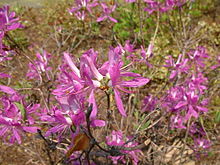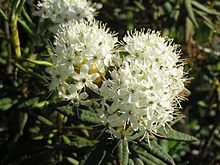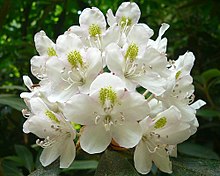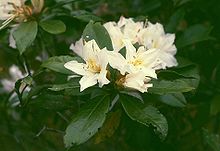
Rhododendron is a very large genus of about 1,024 species of woody plants in the heath family (Ericaceae). They can be either evergreen or deciduous. Most species are native to eastern Asia and the Himalayan region, but smaller numbers occur elsewhere in Asia, and in North America, Europe and Australia.

Gentiana is a genus of flowering plants belonging to the gentian family (Gentianaceae), the tribe Gentianeae, and the monophyletic subtribe Gentianinae. With over 300 species, it is considered a large genus. Gentians are notable for their mostly large trumpet-shaped flowers, which are often of an intense blue hue.

Honeysuckles are arching shrubs or twining vines in the genus Lonicera of the family Caprifoliaceae. It includes 158 species native to northern latitudes in North America, Eurasia, and North Africa. Widely known species include Lonicera periclymenum, Lonicera japonica and Lonicera sempervirens. L. japonica is a highly invasive species considered a significant pest in parts of North America, Europe, South America, Australia, and Africa.
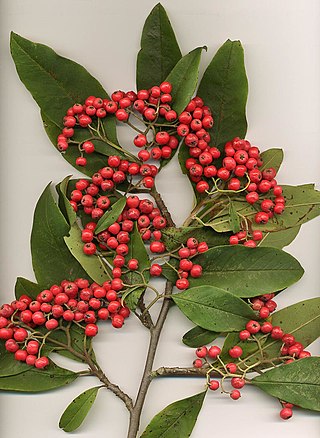
Cotoneaster is a genus of flowering plants in the rose family, Rosaceae, native to the Palaearctic region, with a strong concentration of diversity in the genus in the mountains of southwestern China and the Himalayas. They are related to hawthorns (Crataegus), firethorns (Pyracantha), photinias (Photinia), and rowans (Sorbus).

Gaultheria is a genus of about 283 species of shrubs in the family Ericaceae. The name commemorates Jean François Gaultier of Quebec, an honour bestowed by the Scandinavian Pehr Kalm in 1748 and taken up by Carl Linnaeus in his Species Plantarum. These plants are native to Asia, Australasia and North and South America. In the past, the Southern Hemisphere species were often treated as the separate genus Pernettya, but no consistent reliable morphological or genetic differences support recognition of two genera, and they are now united in the single genus Gaultheria.
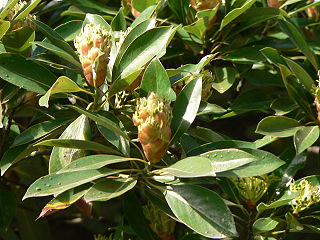
Machilus is a genus of flowering plants in the family Lauraceae. It is found in temperate, subtropical, and tropical forest, occurring in China, Korea, Japan, Taiwan, Indochina, the Indian subcontinent, Malaysia, Indonesia, and the Philippines. It is sometimes included in the genus Persea, and currently includes about 100 species.

Wendlandia is a genus of flowering plants in the family Rubiaceae. It is found in northeastern tropical Africa, and from tropical and subtropical Asia to Queensland.
Brandisia is a genus of flowering plants in the family Orobanchaceae.

Rhododendron rigidum (基毛杜鹃) is a rhododendron species native to Sichuan and Yunnan, China, where it grows at altitudes of 2,000–3,400 m (6,600–11,200 ft). Growing to 1–2 m (3.3–6.6 ft) in height, it is an evergreen shrub with leaves that are elliptic, oblong elliptic, oblong-lanceolate or oblanceolate, 2.5–6.8 by 1–3.2 cm in size. The flowers are white to reddish purple.

Rhododendron uvariifolium (紫玉盘杜鹃) is a rhododendron species native to southwestern Sichuan, southeastern Xizang, and northwestern Yunnan in China, where it grows at altitudes of 2,100–4,000 m (6,900–13,100 ft). It is an evergreen shrub or tree growing to 2–10 m (6.6–32.8 ft) in height, with leathery leaves that are oblanceolate to oblong-oblanceolate or obovate, 11–24 by 3.5–6.5 cm in size. Flowers are white, pink, or rose, with crimson basal blotch and purple spots.

Rhododendron vernicosum (亮叶杜鹃) is a rhododendron species native to western Sichuan, southeastern Xizang, and western Yunnan, China, where it grows at altitudes of 2,600–4,300 m (8,500–14,100 ft). It is an evergreen shrub typically growing to 1–5 m (3.3–16.4 ft) in height, with leathery leaves that are oblong-ovate to oblong-elliptic, and 5–12.5 × 2.3–4.8 cm in size. The flowers are somewhat fragrant, and pale pink or white.
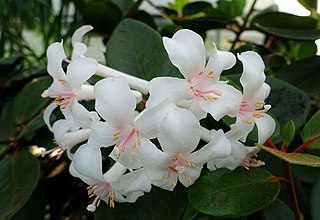
Rhododendron jasminiflorum is a rhododendron species native to Peninsular Malaysia, Borneo, Sumatra, and the Philippines.
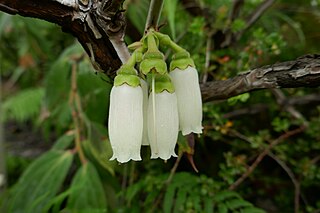
Dimorphanthera is a genus of flowering plants belonging to the family Ericaceae.
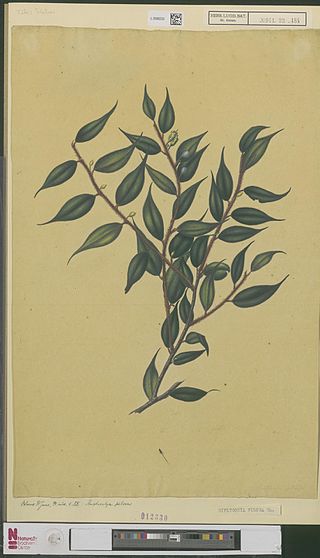
Diplycosia is a genus of flowering plants belonging to the family Ericaceae. Plants of the World Online now treats the genus as a synonym of Gaultheria.






